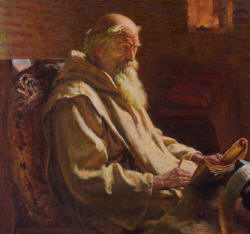
The Ecclesiastical History Of The English Nation -Venerable Bede
CHAP. XVI
THE ACCOUNT GIVEN BY THE AFORESAID BOOK OF THE PLACE OF OUR LORD’S NATIVITY, PASSION AND RESURRECTION
HE wrote concerning the place of the nativity of our Lord, to this effect. “Bethlehem, the city of David, is seated on a narrow ridge, encompassed on all sides with valleys, being a thousand paces in length from east to west, the wall low without towers, built along the edge of the plain on the summit. In the east angle thereof is a sort of natural half cave, the outward part where of is said to have been the place where our Lord was born; the inner is called our Lord’s Manger. This cave within is all covered with rich marble, over the place where our Lord is said particularly to have been born, and over it is the great church of St. Mary.” He likewise wrote about the place of his Passion and Resurrection in this manner. “Entering the city of Jerusalem on the north side, the first place to be visited, according to the disposition of the streets, is the church of Constantine, called the Martyrdom. It was built by the Emperor Constantine, in a royal and magnificent manner, on account of the cross of our Lord having been found there by his mother Helen. From hence, to the westward, appears the church of Golgotha, in which is also to be seen the rock which once bore the cross with our Saviour’s body fixed on it. and now it bears a large silver cross, with a great brazen wheel hanging over it surrounded with lamps. Under the place of our Lord’s cross, a vault is hewn out of the rock, in which sacrifice is offered on an altar for honourable persons deceased, their bodies remaining meanwhile in the street. To the westward of this is the Anastasis, that is, the round church of our Saviour’s resurrection, encompassed with three walls, and supported by twelve columns. Between each of the walls is a broad space, containing three altars at three different points of the middle wall; to the north, the south, and the west, it has eight doors or entrances through the three opposite walls; four whereof front to the north-east, and four to the south-east. In the midst of it is the round tomb of our Lord cut out of the rock, the top of which a man standing within can touch; the entrance is on the east; against it is laid that great stone, which to this day bears the marks of the iron tools within, but on the outside it is all covered with marble to the very top of the roof, which is adorned with gold, and bears a large golden cross. In the north part of the monument, the tomb of our Lord is hewed out of the same rock, seven feet in length, and three palms above the floor; the entrance being on the south side, where twelve lamps burn day and night, four within the sepulchre, and eight above on the right hand side. The stone that was laid at the entrance to the monument, is now cleft in two; nevertheless, the lesser part of it stands as a square altar before the door of the monument; the greater part makes another square altar at the east end of the same church, and is covered with linen cloths. The colour of the said monument and sepulchre appears to be white and red.”

 Support Site Improvements
Support Site Improvements